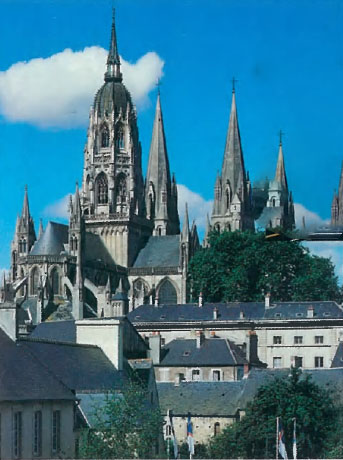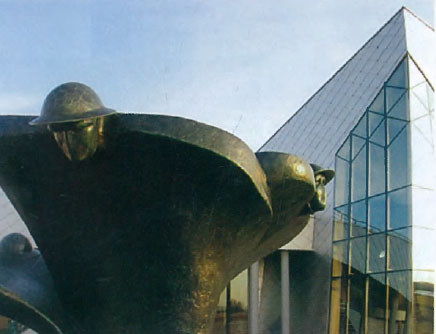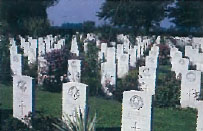
[caption id="DdayRememberedinNormandy_img1" align="aligncenter" width="762"]

COURTESY BAYEUX TOURISM
British Heritage crosses the English Channel to explore the many museums and memorials to the Allied invasion of Normandy in 1944, and some that recall the Norman invasion of England in 1066.
The city of CAEN, one of the initial objectives of D-Day, waited until July for liberation from the Nazis. The Caen Memorial, a museum for peace, was built on the site of German General Richter’s blockhouse. It covers the turning points of WWII and has a Nobel Peace Prize gallery. Tel: Oil 33 2 31 06 06 44. Monuments to Britain’s 3rd Infantry Division, to a Canadian soldier who fell in the battle for Caen, and to the Glengarry Highlanders, who were among the first Allied troops to enter Caen, dot the city. Web: www.ville-caen.fr.
William the Conqueror founded two abbeys at Caen and was buried at the chapel he had built at St. Stephen’s (Saint-Etienne). His burial was singularly lacking in dignity due to William’s great girth, the extended time the royal corpse had been exposed to warm weather, and a property dispute over the site of his final rest (more on this on the British History Online page, BritishHeritage.com). Hundreds of years later, in 1944, Caen residents took refuge in St. Stephen’s and one of William ’s abbeys, Abbaye aux Hommes.
The Pegasus Memorial Museum in RANVILLE-BENOUVlLLE, near Caen, recalls the capture of Pegasus Bridge by the 6th Airborne Division, the first Allied success of D-Day. Web: www.normandyl944.com; tel: Oil 33 2 31 78 19 44.
[caption id="DdayRememberedinNormandy_img2" align="aligncenter" width="343"]

[caption id="DdayRememberedinNormandy_img3" align="aligncenter" width="228"]

BAYEIIX was among the first French towns to be liberated, on 7th June. The Germans just picked up and left, leaving the town largely without battle scars. It’s another place with dual 1066 and 1944 associations. Here is the Bayeux Tapestry Museum (see page 30), where visitors can see the events of 1066 in needlework, and the Battle of Normandy Memorial Museum, with 1944 documents, military equipment, and a film. Tel: 011 33 2 31 51 46 90. The Commonwealth War Graves Cemetery lies along the main road leading to Bayeux. Allied war dead Near Bayeux is BESSIN with its Museum of Underwater D-Day wrecks, tel. Oil 33 2 31 21 17 06. The two towns plan ceremonies and celebrations on 5th and 6th June.
[caption id="DdayRememberedinNormandy_img4" align="aligncenter" width="436"]

ARROMANCHES is also close by. It has a D-Day museum (see page 49) overlooking Gold Beach, as well as Arromanches 360°, a round theatre where an 18-minute film of archival and present-day images, The price of Freedom, is presented on nine screens. Web: www.arromanches360.com; email: [email protected]; tel: Oil 33 2 31 22 30 30.
The Utah Beach Landing Museum is at SAINTE MARIE DU MONT. The strikingly modern structure houses scale models of the German defenses and of the Allied conquest of Utah Beach as well as the evolution of the front. Photos and maps are on display. Web: www.utah-beach.org; email: [email protected]; tel: 01133233715335.
STE MARIE EGLISE, liberated during the night of 5th-6th June, has the Airborne Museum, composed of two buildings shaped like parachutes. Inside are an authentic Waco glider and a C-47 Dakota aircraft like those that dropped paratroopers and towed gliders. There are also displays of weapons, documents, uniforms, and a liberty torch presented to the museum by U.S. President Dwight Eisenhower, as well as first-person accounts and personal objects donated by American veterans. Web: www.airborne-museum.org/ang/lavisite.htm; email: [email protected]; tel: Oil 33 2 33 41 41 35.
These are just a few of many places where Normandy remembers the Allied invasion. Three WEBSITES, www.normandiememoire.com, www.normandydday.com, and www.6june44.freeserve.co.uk, offer a roundup of WWII sites. They have both French and English versions, as do most of the websites mentioned above (in some you click on a British or American flag). And you’ll find that the people who answer the telephone are comfortable speaking English (to call the French phone numbers throughout this issue from the U.S., dial the numbers exactly as they appear). Some sites offer reduced or free admission to WWII veterans, though a few require proof of military service.
[caption id="DdayRememberedinNormandy_img5" align="aligncenter" width="204"]

[caption id="DdayRememberedinNormandy_img6" align="aligncenter" width="203"]

Escorted D-DAY TOURS take you there without the hassle of making your own arrangements. The History Channel’s tours, “D-Day, Battle of the Bulge, Normandy to Berlin,” go to WWII sites in England, France, Belgium, and Germany on 11 departure dates, May through November. Web: www.HistoryTravel.com; email: [email protected]; tel: 877-238-6877.
BRITISH HERITAGE’S travel partner, Lord Addison, takes a tour group to England in August for “D-Day & Their Finest Hour.” Web: www.Lord Addison.com; email: [email protected]; tel: 800-326-0170.





Comments